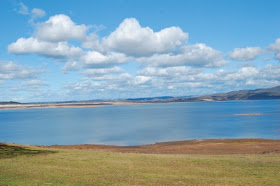The first widely accepted system for
cloud classification was devised by English naturalist Luke Howard in 1803. It
divided clouds into four basic categories:
1.
Cirrus—thin,
wispy clouds of ice
2.
Stratus—layered
clouds
3.
Cumulus—clouds
having vertical development
4.
Nimbus—rain-producing
clouds
 Generalized Cloud Chart:
Generalized Cloud Chart:
Our
current classification scheme is a modified version of Howard’s, retaining his
four categories and also allows new combinations. The ten principle types of
clouds that result are then grouped according to their height and form:
High Clouds
(greater
than 19,000 ft)
|
Cirrus
(Ci)
|
Thin,
white, wispy clouds of ice resembling mares’ tails.
|
|
Cirrostratus
(Cs)
|
Extensive,
shallow clouds somewhat transparent to sunlight, producing a halo around the
Sun or Moon.
|
|
|
Cirrocumulus
(Cc)
|
High,
layered cloud with billows or parallel rolls.
|
||
Middle Clouds
(6,000
ft to 19,000 ft)
|
Altostratus
(As)
|
Extensive,
watery, layer clouds composed of water droplets. Allows some penetration of
sunlight but Moon or Sun appears as bright spot within cloud.
|
|
Altocumulus
(Ac)
|
Shallow,
mid-level cloud containing patches or rolls, often arranged in bands.
Generally more opaque and having less distinct margins than cirrocumulus.
|
|
|
Low Clouds
(below
6,000 ft)
|
Stratus
(St)
|
Uniform
layer of low cloud ranging from whitish to gray.
|
|
Nimbostratus
(Ns)
|
Low
cloud producing light precipitation. Produces darker skies than altostratus.
|
|
|
Stratocumulus
(Sc)
|
Low-level
equivalent to altocumulus with some vertical development.
|
|
|
Clouds with Extensive
Vertical Development
(may
extend through mmm moo atmosphere)
|
Cumulus
(Cu)
|
Detached
billowy clouds with flat bases and moderate vertical development. Sharply
defined boundaries.
|
|
Cumulonimbus
(Cb)
|
Clouds
with intense vertical development with characteristic anvil. May be tens of
thousands of meters thick. Appear very dark when viewed from below. Can
create violent weather.
|
|
Unusual
Clouds:
─ Lenticular Clouds—waves
formed by the passage of air over a topographic barrier.
─ Banner Clouds—isolated
atop mountain peaks
─ Mammatus—found in margins of
cumulonimbus clouds, formed by downdrafts, and sometimes are distorted by
complex motions.
─
Nacreous
Clouds—stratus clouds only observed at high latitudes.
─
Noctilucent
Clouds—in the mesosphere, can illuminate the sky at high
latitudes during the twilight hours. Noctilucent clouds
Other:
─ Aircraft Contrails—A type of ice cloud, know as contrails, is frequently caused by jet aircraft. The very hot engine exhaust contains considerable water vapor as a result of fuel combustion, and turbulence in the wake of the aircraft rapidly mixes the exhaust with the cold, ambient air. The mixing of warm, moist air with cold air can lead to saturation and, in this case, the rapid formation of ice crystals.


























No comments:
Post a Comment